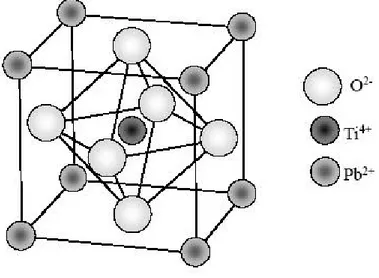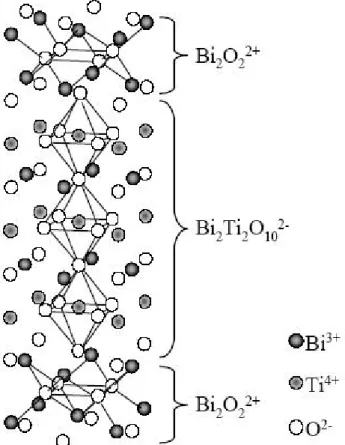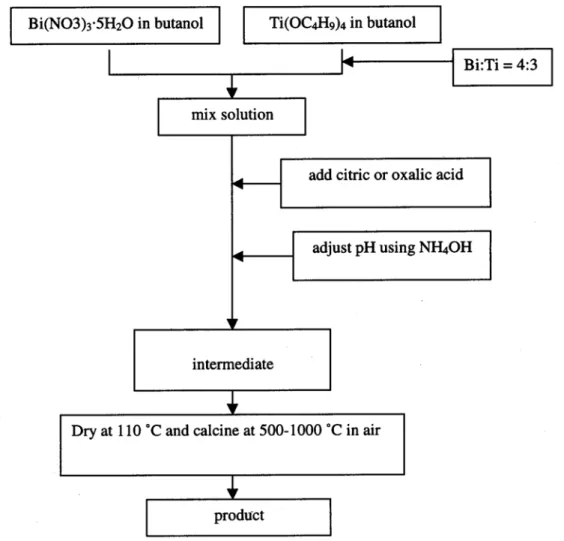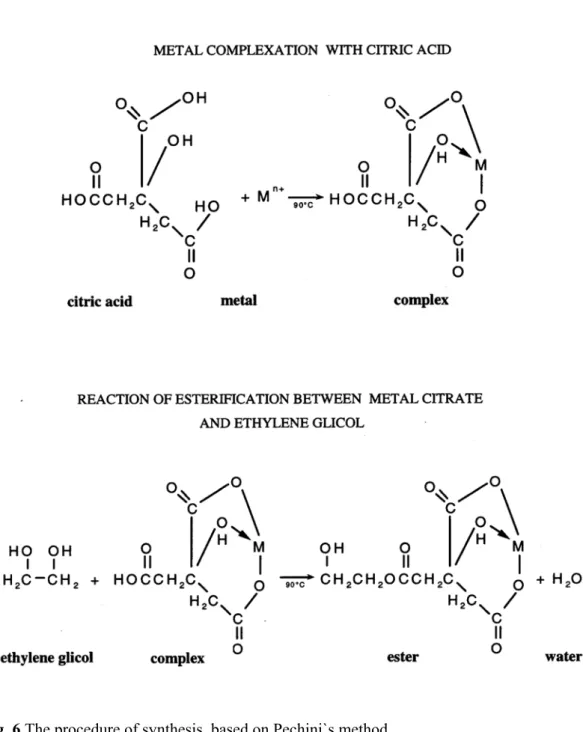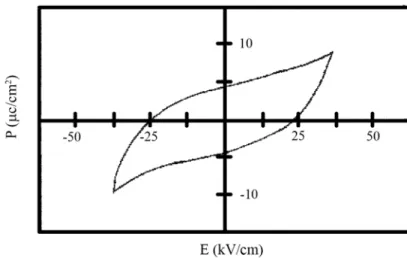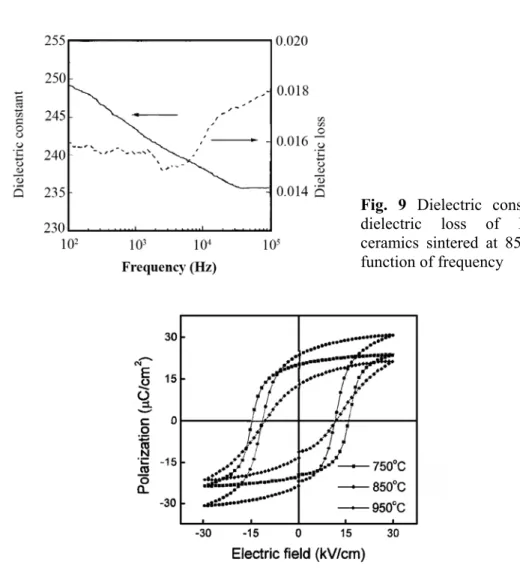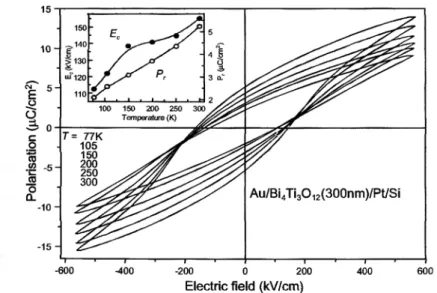_____________________________
*) Corresponding author: Lzorica@softhome.net
DOI: 10.2298/SOS0503199L
UDK 661.887
An Approach to Analyzing Synthesis, Structure and Properties
of Bismuth Titanate Ceramics
Z. Lazarevi
ć
1,2*), B. D. Stojanovi
ć
1,3, J. A. Varela
1 1Instituto de Quimica-UNESP, Araraquara, S.P., Brazil,
2Institute of Physics, Belgrade, Serbia & Montenegro,
3Center for Multidisciplinary Studies University of Belgrade, Belgrade, Serbia
&Montenegro
Abstract:
The family of bismuth titanate, Bi4Ti3O12 (BIT) layered-structured ferroelectrics
materials is attractive from the viewpoint of their application as electronic materials such as dielectrics, piezoelectrics and pyroelectrics, because they are characterized by good stability of piezoelectric properties, a high Curie temperature and a good resistance vs temperature. Bismuth titanate (Bi4Ti3O12) powders can be prepared using different methods, depending if
the creation will be film coating or ceramics. The structure and properties of bismuth titanate materials show a significance dependence on the applied synthesis method. In this review paper, we made an attempt to give an approach to analyszing the structure, synthesis methods and properties of bismuth titanate ferroelectrics materials.
Keywords: Bi4Ti3O12 ceramics; Layered perovskite structure, Synthesis technique, Dielectric
and Ferroelectric Properties
1. Introduction
Bi4Ti3O12, since its discovery in 1949 by Aurivillus [1], has been extensively studied
for its ferroelectric and other excellent properties. Bi4Ti3O12 is a candidate material for high
temperature piezoelectric applications, memory storage, and optical displays because of its high Curie temperature and electrooptical properties [2]. Ferroelectric Bi4Ti3O12 ceramics are
potential candidates for device applications due to their high dielectric constant and high breakdown strength [3, 4]. The properties of Bi4Ti3O12 have been reported in a number of
papers, cited among others in refs [5, 6, 7].
Ceramic materials with a perovskite structure are very significant electronic materials. Bismuth titanate, Bi4Ti3O12 (BIT), belongs to the group of ferroelectric materials
with a perovskite structure. Bismuth titanate is most often used in the production of capacitors as it has a high temperature coefficient of resonant frequency, large dielectric constant and high dielectric losses [8]. Development of wireless telecommunication technologies in the last few years requires very stringent criteria for dielectric ceramic materials. In order to be applied as microwave filters and resonators dielectric ceramic materials must have a high
dielectric constant, low dielectric loss and a thermally stable resonant frequency coefficient [8].
2.
General Features of Ferroelectric Materials
The phenomenon of ferroelectricity was first observed by Valasek in 1921 [8], during an investigation of Rochelle salt (sodium tartarate tetrahydrate). Ferroelectric materials are a special type of dielectric materials that possess a spontaneous dipole. Ferroelectric materials are generally definite by reversible spontaneous polarization in the absence of electric field [9]. Spontaneous polarization is generated from a non-centrosymmetric arrangement of ions in a unit cell, which produces an electric dipole moment related to the unit cell. Adjacent unit cells are inclined to polarize in the same direction and form a region called a ferroelectric domain. A unit cell of a typical ferroelectric material, ABO3, is illustrated in Fig. 1 where A
atom, B atom, and O oxygen occupy the corner site, body-centered site, and face-centered site, respectively.
Fig. 1 The ideal perovskite structure of PbTiO3.
Since the discovery of piezoelectricity BaTiO3 in the 1940`s, the nature and search for
new perovskite ferroelectrics has been guided by traditional crystal chemistry concepts, with limited success. The perovskite structure has a general formula ABO3, where the Roman
numerals represent the corresponding cation: anion coordination number. Based on their geometrical packing, Goldschnidt proposed the concept of a tolerance factor `t` (t < 1) [10]. Ferroelectric materials exhibit a characteristic hysteresis loop as shown in Fig. 2.
Ferroelectric materials are characterized by properties such as a high dielectrical constant, high piezoelectric constants, relatively low dielectric loss and high electrical resistivity. For ordinary dielectric materials the relationship between the applied electric field and the induced polarization is linear. When an electrical field is applied to the ferroelectric material, the B atom, which has two thermodynamically stable positions inside the oxygen octahedral, is displaced relative to the oxygen’s upward or downward, depending on the polarity of the electric field. This displacement generates a dipole moment inside the oxygen octahedral, which is called saturated polarization (±Ps). When the applied electric field is
removed, the B atom remains in the displaced position and generates a residual polarization in the absence of the applied electric field, or remanent polarization (±Pr). In order to reverse the
direction of polarization, it is necessary to apply a coercive electric field (±Ec), which is
applications are its ability to retain two stable remanent polarization values at zero field, thus providing nonvolatility. The state of polarization can be controlled and sensed by reversing the polarization from up (+) to down (0) or vice versa as a function of the applied voltage. For a crystal to exhibit ferroelectricity is has to belong to a non-centrosymmetric space group in a certain temperature range. The breakdown temperature where the non-centrosymmetry and ferroelectric properties are lost is called the Curie temperature (Tc) and above this temperature
the material becomes paraelectric [11, 12].
The ferroelectric properties of such oxides have been known for around 50 years [13], yet the structural origins of their ferroelectricity have only recently been established [14]. The ferroelectric Bi4Ti3O12 phase has a high Curie temperature of 675 ˚C, possesses a high
dielectric strength and a relatively high dielectric constant ~ 200 [15]. At 600 ˚C and below, Bi4Ti3O12 has a tetragonal phase and undergoes the phase transformation to orthorhombic at
750 ˚C [16]. It is useful for various applications such as memory storage, optical display, piezoelectric converters or pyroelectric devices over a wide range of temperatures [17, 18, 19-22].
Fig. 2 A typical P-E hysteresis loop in ferroelectrics.
A large number of ferroelectric systems adopt the perovskite structure such as BaTiO3, BaxSr1-xTiO3 (BST), PbTiO3, PbZr1-xTixO3 (PZT) and Pb1-xLaxZryTi1-yO3 (PLZT) [11,
12]. Many of these ferroelectrics are lead-based but these are believed to be replaced in numerous applications by bismuth based-layered ferroelectrics. This is due to the fact that bismuth-based ferroelectrics consist of pseudo perovskite units sandwiched in between bismuth oxide layers, which gives them a better fatigue nature [23]. In addition there is also a desire to limit the integration of lead containing compounds into electronic products and here bismuth based layered ferroelectrics can be a more environmentally friendly alternative. Bismuth titanate, Bi4Ti3O12, is one of the bismuth based layered ferroelectric materials that is
a candidate for replacing lead based ferroelectric materials in for instance non-volatile ferroelectric random access memories (FRAM) [24, 25].
Ceramics of the Bi4Ti3O12 type of materials are also candidate materials for high
temperature acoustic piezo-sensors [26]. The discovery of ferroelectricity and optical activity in Bi4Ti3O12 single crystals started a vast new area of research [17, 27].
3. Structure of Bi
4Ti
3O
12Bismuth titanate, Bi4Ti3O12 is a bismuth based layered ferroelectric oxide and it
and early 1950s [28, 29]. The structure of the so-called Aurivillius phases can simply be described by the general formula (Bi2O2)2+ (Mn-1RnO3n+1)2- where n can have the number 1 to
6. The (Mn-1RnO3n+1)2- formula unit consists of n pseudo perovskite units which are
sandwiched in between two (Bi2O2)2+ layers. The M cation is a rather large mono-, di- or
trivalent cation (e.g. Na+, Pb2+, Bi3+) and the R cation is smaller in size and either a tri-, tetra-, penta-or hexavalent cation (e.g. Fe3+, Ti4+, Ta5+, W6+) [30-32]. The R is a diamagnetic transition metal such as Ti4+ or Nb5+ and M is an alkali or alkaline earth cation [28]. The structure of Aurivillius oxides consists of arrays of Bi2O2 and perovskite-like Mn-1RnO3n+1
layers. Several different compounds having this general formula have been synthesized and structurally determined since the original work of Aurivillius, e.g. SrBi2Ta2O9 (n = 2),
Bi4Ti3O12 (n = 3) and BaBi4Ti4O15 (n = 4) [17, 33-35]. In Fig. 3 a simplified crystal structure
of Bi4Ti3O12 is shown. The three pseudo perovskite units and bismuth oxide layers have been
marked.
Fig. 3 Idealized structure of Bi4Ti3O12 showing the bismuth oxide layers and pseudo
perovskite units.
More recently, Aurivillius phases have been the subject of renewed interest due to their attractive anion properties. Hence, Bi4Ti3O12 possesses an electrical conductivity that is
highly anisotropic, with the maximum value in the same plane as the polarization [27]. As this conductivity is relatively high, it is very difficult to pole [36]. Having this in mind, synthesis of more resistive Bi4Ti3O12 ceramics would be a preferable advance in obtaining of
well-densified ceramics with small grains randomly oriented to limit the conductivity along the (Bi2O2)2+layers [36].
Bi4Ti3O12 is monoclinic at room temperature, very–high–resolution powder
diffraction data suggest that powder samples of Bi4Ti3O12 areactually orthorhombic at room
temperature [37]. In addition to the ferroelectric Bi4Ti3O12 phase [27, 38, 39] the ternary
[40] and the electrooptical and photo-conducting Bi12TiO20 phase [41]. The phase diagram of
the Bi2O3-TiO2 system has been investigated by Speranskaya et al. [42].They reported the
existence of two additional phases: Bi8TiO14 and Bi2Ti4O11. There are some divergent
opinions about the true symmetry of the ferroelectric Bi4Ti3O12 phase. It has optically been
determined to be monoclinic but diffraction studies have defined it as orthorhombic [27, 28, 43, 44]. The reason for this is that the optically determined monoclinic β-angle is very close to 90˚.
Bi4Ti3O12 single crystals demonstrate bi-axial polarization. Along the a-axis they can
be polarized up to 50 µC/cm2 while the polarization along the c-axis does not exceed 4 µC/cm2 [27]. Bi4Ti3O12 also has a unique rotation of the optical indicator upon polarization
switching [45].
4. Methods for synthesis of Bi4Ti3O12 ceramics
Bi4Ti3O12 ceramics were conventionally prepared by a solid-state reaction process,
where an oxide mixture of Bi2O and TiO2 was ball milled, calcined at an intermediate
temperature and finally sintered at a high temperature [46, 47, 48]. The conventional method requires a high calcination temperature, usually leading to inevitable particle coarsening and aggregation of Bi4Ti3O12 powders. The presence of hard particle agglomerates will also results
in a poor microstructure and properties of Bi4Ti3O12 ceramics [49]. Many efforts have been
made to avoid this problem by lowering the calcination temperature. The methods reported in literature for preparing Bi4Ti3O12 ceramics include co-precipitation [46, 50, 51], sol-gel [52,
53], hydrothermal [54], and molten salt synthesis [55].
Bi4Ti3O12 synthesis techniques were mentioned in a lot of papers. All techniques and
methods can produce ceramics with device-quality characteristics. Numerous different thin film deposition techniques exist, and these techniques are usually divided in two main groups, Physical Vapor Deposition (PVD) and Chemical Vapor Deposition (CVD) [56].
4.1. Chemical methods for Bi
4Ti
3O
12powder synthesis
A lot of papers showed the advantages of chemical methods. Most ceramic techniques consist of control of morphology, particle size, homogeneity and possible reduction in the sintering temperature. A Bi4Ti3O12 precursor can be prepared by
coprecipitating bismuth and titanium hydroxides. Most of the chemistry-based preparation routes for Bi4Ti3O12 involve calcination at elevated temperatures in order to realize the
precursor-to-ceramic conversion. In a completely different approach using an amorphous Bi4Ti3O12 hydroxide precursor, nanocrystalline particles of layered perovskite Bi4Ti3O12 are
synthesized by mechanical activation, skipping the detrimental crystallite coarsening and particle aggregation encountered at high temperatures.
Sol-gel is a method for preparing metal oxide glasses and ceramics by hydrolyzing a chemical precursor to form a sol and then a gel, which on drying (evaporation) and pyrolysis gives an amorphous oxide. Upon further heat treatment crystallization can be induced. There are three basic steps involved: (i) partial hydrolysis of metal alkoxides to form reactive monomers; (ii) polycondensation of these monomers to form colloid-like oligomers (sol);(iii) additional hydrolysis to promote polymerization and cross-linking leading to a 3-dimensional matrix (gel) [57, 58].
Step 1- Partial hydrolysis
M(OR)n + mH2O ---... M(OR) n-m(OH) m + ROH
Step 2 -Condensation
2 M(OR) n-m(OH) m ---... (OR) n-mM-O- M(OR) n-m + HOH
or
(OR) n-1M-(OR) + (HO)-M(OR) n-1 ---...(OR) n- 1M-O-M(OR) n-1 + ROH
Step 3
3D cross-linking between (RO) n-mM-O-M(OR) n-m molecules
In the sol-gel technique, the structural and electrical properties of the final product (films) are strongly dependent on the nature of precursor solution, deposition conditions, and the substrate. Sedlar and Sayer [59] describe a modified sol-gel method. Bismuth nitrate Bi (NO3)3·5H2O was dissolved in concentrated nitric acid or glacial acetic acid, diluted and
mixed with titanium stock solution. The latter solution consists of titanium isopropoxide, acetylacetone and methoxyethanol mixed in the molar ratio 1:1:4. Gu and others [60] prepared a Bi-Ti solution by mixing bismuth nitrate and titanium butoxide in the presence of acetic acid. Rao and others [61] prepared Bi4Ti3O12 by the above two methods. Bismuth
nitrate Bi(NO3)3·5H2O, and titanium isopropoxide, Ti(OC3H7)4 were the starting materials.
Bismuth hydroxide was prepared by dissolving bismuth nitrate in water containing a sufficient amount of nitric acid to give a clear solution, which was then added slowly to an equal volume of concentrated ammonia under constant stirring. Titanium hydroxide was prepared by dissolving Ti(OC3H7)4 in isopropanol and adding this solution slowly to a
mixture containing 1:1:2 ammonium hydroxide (30%)-isopropanol and deionised water while stirring. Known amounts of bismuth and titanium hydroxides were individually heat treated at 600 ˚C for 1h to determine the exact amounts of Bi2O3 and TiO2 contents in the required
proportion so as to yield 0.02 mol stoichiometric Bi4Ti3O12 and made into a slurry with 1:1
ammonium hydroxide, stirred for about 12h and dried at 60 ˚C. Rao and others authors [60] showed a second way of synthesis of Bi4Ti3O12 from a sol-gel process. Bismuth acetate
Bi(CH3COO)3 and Ti(OC3H7)4 were the starting materials with 2-methoxy ethanol (2-MOE)
and acetic acid (HAC) as a solvent for sol-gel synthesis. 0.04 mol of Bi(CH3COO)3 was added
to a mixture containing 2-MOE and HAC in the ratio 2:1. The wet gel was dried in an oven at 100 ˚C and the gel powder was heat treated at 300 ˚C for several hours until all carbon was removed. From their results it is apparent that Bi4Ti3O12 can be easily synthesized from
corresponding hydroxide precursors at a temperature as low as 750 ˚C. Pellets derived from a mixture of hydroxide precursors showed a density close to 88 % of the theoretical density that was slightly higher than that of pellets derived from the sol-gel method.
Dhage and other [62] used a simple citrate-gel process to prepare nanocrystalline Bi4Ti3O12 (Fig. 4). The citrate gel process offers a number of advantages for the preparation of
fine powders of many complex oxides as quoted in literature [63-66]. Bi2O3, TiCl4 and citric
acid were used for the preparation of Bi4Ti3O12. TiCl4 was diluted with ice-cold water to form
TiOCl2; a stoichiometric quantity of Bi2O3 was dissolved in hydrochloric acid and added to
the mixture containing the required amount of TiOCl2 and heated in a water bath. The molar
ratio used for Bi:Ti:citric acid was 4:3:7. Since there was no precipitation during mixing, the pH of the solution was not varied. On heating in a water bath at 373 K, a light yellowish gel was formed after evaporation of water. Subsequently, the gel was decomposed at various temperatures ranging from 423 to 1173 K. The gel initially started to swell and filled the beaker producing a foamy precursor. This foam consisted of very light and homogeneous flakes of a very small particle size. On the basis of all experimental results it can be concluded that the values of coercive field and spontaneous polarization obtained for the citrate method are superior to those for ceramic samples.
microwave, mechanical mixing, and electrochemical reactions. The duration of the experiments is reduced by two orders of magnitude, at least, which makes the technique more
economic. The microwave hydrothermal technique is more economic. The microwave
hydrothermal technique is especially handy for synthesis of oxide ceramics. Additionally, the crystal size, morphology and level of agglomeration of different ceramic oxides can be controlled through careful selection of the ratio of starting materials, pH, time, and temperature. Submicron sized powders of TiO2, ZrO2, KNbO3, BaTiO3, and others, and their
solid solutions have been prepared by this way. This has made the technique a more valuable one in the low temperature production of fine ceramic powders [67-69].
Fig. 4 Shematic diagram used for preparing citrate and oxalate intermediates and the final product.
As a method for synthesizing high quality powders that have many advantages, such as a high degree of crystallinity, well-controlled morphology, high purity and narrow particle size distribution, hydrothermal synthesis was regarded as a promising way to prepare bismuth titanate powders [70, 71]. Until now, several papers have reported on successful synthesis of bismuth titanate powders by hydrothermal processes. The starting materials for hydrothermal synthesis may be all kinds of compounds that can be dissolved in water under high-temperature and high-pressure. Yang and other [72] used titanium butoxide (Ti(OC4H9)4),
titanium chloride (TiCl4) and anatase titania (TiO2) powder as titanium salts, bismuth nitrate
experiment. The hydrothermal process of bismuth titanate is shown in Fig. 5. Bi4Ti3O12
nanocrystalline particles were hydrothermally synthesized at temperatures of 180-230˚C. The crystallinity and particle sizes of Bi4Ti3O12 powders increased with rinsing reaction
temperature and time.
A simple urea precipitation route was adopted for the preparation of Bi4Ti3O12
powders. Urea is used as fuel, precipitating agent and as a resin former with formaldehyde [73-77]. When urea is used along with nitrate salt of a cation and heated at 673 K, an exothermic reaction between nitrate (oxidant reactant) and urea (fuel) leads to the formation of corresponding nanocrystalline oxides. The main advantage is that the necessary heat for synthesis is obtained directly from the reaction [73, 74]. Urea decomposed around 373 K to produce carbon dioxide and ammonia, thereby increasing the pH of the solution at which metal cation precipitation takes place [75]. Dhage and other used Bi2O3, TiCl and urea for the
preparation of bismuth titanate. The molar ratio used was Bi:Ti:urea = 4:3:35. The precipitate was decomposed at various temperatures ranging from 423 to 1173 K. The precipitate initially started to swell and fill a beaker, producing a foamy precursor. This foam consisted of very light and homogeneous flakes of a very small particle size. The values of the coercive field and spontaneous polarization obtained for the urea method are superior to those samples prepared by the ceramic method [76].
Fig. 5 Flow chart of the hydrothermal process.
α-hydroxycarboxylic organic acid can form polybasic acid chelates with several cations. After addition of a polyhydroxylic alcohol and heating, the chelate transforms into a polymer, with homogeneously distributed cations. The organic part is subsequently eliminated at temperatures as low as 300˚C, forming reactive oxides with well-controlled stoichiometry.
Fig. 6 The procedure of synthesis, based on Pechini`s method.
4.2
Mechanically assisted synthesis
is grinding bodies compared to the grains of materials being ground [79]. Mechanical activation is a process during which, from the viewpoint of changes of free energy, changes occur in the amount of accumulated energy. During the formation of a new surface, the increase of the energy in surface layers occurs. In that stage the starting material is transformed into a new material with a completely different structure and properties. Even though the mechanisms of energy exchange during these processes are not completely clear, they efficiently contribute to mechanical activation, generally leading to physical and in some cases to chemical changes in the material. Proper selection of milling parameters has an influence on the onset of the solid-state reaction. Intensive milling enables increased reactivity of the starting powders due to appropriate physicochemical changes in the material, which can lead to a reduction in the synthesis temperature. The chemical reactivity of starting materials could be improved significantly upon appropriate mechanically assisted treatment and the subsequent calcination temperature for forming the ceramic phase was lowered.
A mechanochemical process, which is also known as mechanical alloying, has been recently employed to prepare nano-sized oxides and compounds, superconductors, magnetic ferrites and ferroelectric powders [80]. This mechanical technique is superior to both the conventional solid-state reaction and the wet-chemistry-based processing routes for ceramic powders for several reasons. It uses low-cost and widely available oxides as the starting materials and skips the calcinations step at an intermediate temperature, leading to a simplified process [81]. Furthermore, the mechanically derived powders possess a much higher sinterability than those powders synthesized by conventional solid-state reaction and most of the wet-chemical processes [82].
There are a number of unique phenomena associated with mechanical activation, including refinement in crystallite size, amorphization of crystallite phases, creation of point, surface and lattice defects, phase transformations and crystallization from an amorphous state and chemical reaction [80]. In addition, the nucleation and subsequent growth of perovskite crystallites were triggered by mechanical activation at room temperature [81].
Formation of bismuth titanate during mechanical activation starting from Bi2O3 and
TiO2 has been the subject of research of lot of authors. Synthesis of bismuth
titanate,Bi4Ti3O12, was performed by mechanical activation and thermal treatment. Milling for
up to several hours in a planetary ball mill mechanically activated an equimolar mixture of Bi2O and TiO2 powders. A small amount of mechanically activated mixtures have been
pressed into briquettes and calcined at high temperature. Kong and coauthors [80], prepared nano-sized Bi4Ti3O12 powders directly from their oxide mixture by a high-energy ball milling
process. A Bi4Ti3O12 phase can be formed after milling for 9h. An almost single phase of
Bi4Ti3O12 ceramics was obtained by sintering the synthesized powders at temperatures ranging
from 750–950˚C. Bi4Ti3O12 ceramics sintered at 850˚C for 1h exhibited a density of 7.91 g
cm-3.
5. Properties of Bi
4Ti
3O
12Bi4Ti3O12 is a materialwith a typical plate-like microstructurethat has anisotropic
properties, a low coercive field (Ec), small remnant polarization (Ps) excellent fatigue
properties and retention time. The synthesis route has a strong influence on the structure and properties of BIT.
Fig. 7 Microstructure of Bi2O3 · 2TiO2 ceramics sintered at 1150 ˚C in air for 3h.
Fig. 8 Hysteresis loop of Bi4Ti3O12 prepared by the citrate method.
Dhages and co-authors [62] synthesized Bi4Ti3O12 by the citrate method showing the
influence of processing on ferroelectric properties (Fig. 8). The ferroelectric hysteresis loop parameters measurements of the pellet sintered at 1273 K showed the values of spontaneous polarization, Ps = 9 µC cm-2, remnant polarization, Pr = 4 µC cm-2 and coercive field, Ec = 25
kV cm-1 at an applied voltage of 53.6 kV cm-1 without an electric breakdown occurring. The relative density of the pellet was 90%. The reported values of these parameters varied in the range of Ec = 25-100 kV cm-1 and Ps∼ 24-40 µC cm-2 depending on preparation conditions
[80]. The samples prepared by the ceramic technique have Ps = 2 µC cm-2, remnant
polarization Pr = 0.5 µC cm-2 and coercive field, Ec = 23 kV cm-1at an applied field of 40 kV
cm-1 without an electric breakdown occurring.
Bi4Ti3O12 ceramics wereconventionally prepared by a solid-state reaction process,
where an oxide mixture of Bi2O3 andTiO2 was ball milled [80]. Fig. 9 shows the dielectric
constant and dielectric loss of Bi4Ti3O12 ceramics sintered at 850 ˚C for 1h, as a function of
frequency from 100 Hz to 100 kHz at room temperature. The dielectric slightly decreases within the measured frequency range. Dielectric loss remains almost constant from 100 kHz to 10 kHz and increases thereafter. Dielectric constants of Bi4Ti3O12 ceramics sintered at
750 ˚C and 950˚C are 189 and 312, respectively. P-E hysteresis loops of Bi4Ti3O12 ceramics
Fig. 9 Dielectric constant and dielectric loss of Bi4Ti3O12
ceramics sintered at 850˚C as a function of frequency
Fig. 10 Representative P-E hysteresis loops for Bi4Ti3O12 ceramics.
The remnant polarization and coercive field are derived from the loops and are plotted in Fig. 11 [80].
Fig. 11 Ferroelectric parameters of Bi4Ti3O12
ceramics as a function of sintering temperature.
Fig. 12 Impedance characteristic curve of Bi4Ti3O12 ceramics sintered at different
Fig. 12 [80] shows the impedance characteristic curve of Bi4Ti3O12 ceramics sintered
at 850˚C for 1h. Piezoelectric parameters calculated from the impedance-frequency curves as a function of the sintering temperature are shown in Fig. 13 [80]. The samples sintered at 850˚C exhibit the best piezoelectric property.
The pyroelectric coefficient as a function of measuring temperature for the Bi4Ti3O12
ceramics sintered at 850˚C for 1h is presented in Fig. 14 [80]. The fresh-sintered sample shows a broadened peak at about 100˚C, which disappears when measured for the second time with a great reduction in the pyroelectric coefficient. The fresh-poled sample exhibits the
most distinguished pyroelectric property with a maximum value at about 175˚C, which
diminishes when measured for the third time, of the poled sample remains almost unchanged, especially at the end of low temperature. This indicates a rather strong influence of processing and measurement’ conditions on the BIT properties.
Kong and coauthors [80], prepared nano-sized Bi4Ti3O12 powders directly from their
oxide mixture by a high-energy ball milling process. A Bi4Ti3O12 phase can be formed after
milling for 9h. An almost single phase of Bi4Ti3O12 ceramics was obtained by sintering the
synthesized powders at temperatures ranging from 750–950˚C. Bi4Ti3O12 ceramics sintered at
850˚C for 1h exhibited a density of 7.91 g cm-3, a dielectric constant of 243, a dielectric loss of 0.017, a remnant polarization of 24 µC cm-2 and a coercive field of 11 kV cm-1, respectively.
Fig. 13 Piezoelectric coupling coefficient of Bi4Ti3O12 ceramics as a function of the
sintering temperature.
Fig. 14 Piroelectric coefficient curves of Bi4Ti3O12 ceramics sintered at 850 ˚C for
1h: (a) fresh sintered sample, (b) second measurement of the fresh sample, (c) fresh poled sample, (d) second measurement of the poled sample and (e) third measurement of the poled sample.
Piezoelectric parameters of the Bi4Ti3O12 ceramics are k33 = 56%, k31=58 %. The
Bi4Ti3O12 ceramics also possessed good pyroelectric properties. These results indicate that the
Fig. 15 Capacitance-voltage (C-V) characteristic.
Many authors investigated the properties of bismuth titanate thin films. Schuisky [84] demonstrates the electric field dependence of the dielectric permittivity ε for film deposited by the conventional CVD method. The measurement was carried out at a frequency of 100 kHz ( Fig. 15). C-V characteristics are non-linear with a hysteresys behavior. Attainability as
high as 51% was achieved since ε could be decreased to 51% of the maximum value by
applying a bias voltage of 10.5 V (electric field strength of 350 kV cm-1).
Fig. 16 Ferroelectric polarization loops measured at various temperatures. Ec and Pr
vs. temperature are shown in the insert.
precursors such as metal iodides, BiI3 and TiI4. Fig. 16 [83] shows ferroelectric hysteresis P-E
polarization loops traced at various temperatures. Measurements at room temperature yield the remanent polarization Pr = 5.3 µC cm-2, induced polarization of 14.9 µC cm-2 at 560 kV
cm-1, and coercive field as high as 150 kV cm-1. It is important to note that the values for thin films compared to bulk are different .
6. Applications of Bi4Ti3O12
It was pointed out that bismuth titanate belongs to the Aurivillius family, having three oxygen octahedrals between two bismuth oxide layers. Its crystal symmetry in the paraelectric phase is tetragonal, and it appears that Bi4Ti3O12 is one of the few compounds within the
Aurivillius family that has a monoclinic ferroelectric structure, with one component of polarization in plane of the layers. The resulting domain-wall structure is complex, leading to complicated but also interesting electric and piezoelectric properties. Bi4Ti3O12 is a
ferroelectric material, which in thin film form can be used for ferroelectric or electrooptic devices [85]. High Curie temperature, excellent fatigue behavior and reasonable ferroelectric properties make Bi4Ti3O12 an attractive candidate for ferroelectric (FERRAM) or dynamic
(DRAM) random access memories [85]. Bi4Ti3O12 films formed on a superconductor showed
promising ferroelectric properties and the potential for integration into a semiconductor device processing technology [86]. Single crystal Bi4Ti3O12 has low dielectric permittivity,
which makes it useful for various applications such as memory elements, optical displays, and piezoelectric converters of pyroelectric devices in a wide temperature range from 20-600 ˚C. Bi4Ti3O12 ceramics have been used in capacitors, tranducers, sensors, etc [87].
References
1. B. Aurivillius, Arkiv Kemi, 1, 499 (1949).
2. J. S. Patwardhan, M. N. Rahaman, J. Mater. Sci., 39, 133 (2004). 3. J. F. Dorrian, R. E. Newnham, K. K. Smith, Ferroelectrics, 3, 17 (1971).
4. H. S. Shulman, M. Testorf, D. Damjanovic, N. Setter, J. Am. Soc., 79 (12), 3214 (1996).
5. A. Megriche, L. Lebrun, M. Troccaz, Sensors and Actuators, 78, 88 (1999). 6. I. Hiroshi, M. Masaru, K. Tetsuichi, J. Appl. Phys., 90 (8), 4089 (2001). 7. T. Thongtem, S. Thongtem, Mater. Lett., 58, 2842 (2004).
8. J. Valasek, Phys. Rev., 17, 475 (1921).
9. M. Lines, A. Glass, Principles and Applications of Ferroelectrics and related devices, Clarendon Press, Oxford, 87 (1977).
10. V. M. Goldschmidt, Skrifter Norske Videnskops – Akad. Oslo, I: Mat. –Natur. K1. No. 2 (8), (1926).
11. H. D. Megaw, Ferroelectricity in Crystals, Methuen and Co, London, (1957). 12. Y. Xu, Ferroelectric Materials and Their Applications, North Holland, Amsterdam,
(1991).
13. G. A. Smolenskii, V. A. Isupov, A. I. Agranovskaya, Sov. Phys. Solid State, 3, 651 (1961).
14. Q. Zhou, B. J. Kennedy, C. J. Howard, Chem. Mater., 15, 5025 (2003).
15. T. Takenaka, T. Gotoh, S. Mutoh, T. Sasaki, Jpn. J. Appl. Phys. Part 1, 34, 5384 (1995).
16. Y. Kan, P. Wang, Y. B. Cheng, D. Yan, Mater. Lett., 56, 910 (2002). 17. E. C. Subbarao, J. Phys. Chem. Solids, 23, 665 (1962).
19. V. Y. Du, J. Fang, M. Zhang, J.Hong, Z. Yin, Q. Zhang, Mater. Lett., 57, 802 (2002).
20. Y. Shi, C. Cao, S.Feng, Mater. Lett., 46, 270 (2000). 21. A. Fouskova, L. E. Cross, J. Appl. Phys., 41, 2834 (1970).
22. A. Q. Jiang, G. H. Li, L. D. Zhang, J. Appl. Phys., 83, 4878 (1998).
23. C. A. Paz de Araujo, J. D Cuchiara, L. D. McMillan, M. C. Scott, J. F. Scott, Nature, 374, 627 (1995).
24. K. Sugibuchi, Y. Kurogi, N. Endo, J. Appl. Phys., 46, 2877 (1975).
25. S. Sinharoy, H. Buhay, D. R. Lampe, M. H. Francombe, J. Vac. Sci. Technol. A, 10, 1554 (1992).
26. A. Megricke, L. Lebrun, M. Troccaz, Sensos and Actuators, 78, 88 (1999). 27. E. Cummins, L. E. Cross, J. Appl. Phys., 39(5), 2268 (1968).
28. B. Aurivillius, Arkiv Kemi, 1, 463 (1949). 29. B. Aurivillius, Arkiv Kemi, 2, 519 (1950).
30. M. Villegas, C. Moure, J. F. Fernandez, P. Duran, Ceram. Int., 22, 15 (1996). 31. M. Villegas, C. Moure, J. F. Fernandez, P. Duran, J. Mater. Sci., 31, 949 (1996). 32. A. M. Umabala, M. Suresh, A. V. Prasadarao, Mater. Lett., 44, 175 (2000). 33. T. Kikuchi, A. Watanabe, K. Uchida, Mater. Res. Bull., 12, 299 (1997).
34. T. Takenaka, T. Gotoh, S. Mutoh, T. Sasaki, Jpn. J. Appl. Phys. Part 1, 34, 5384 (1995).
35. E. C. Subbarao, Integr. Ferroelectr., 12, 33 (1996).
36. S. Kojima, A. Hushur, F. Jiang, S Hamazaki, T. Takashige, M. S. Jang, S. Shimada, J. Non-Cryst. Solidas, 293-295, 250 (2001).
37. C. H. Hervoches, P. Lightfoot, Chem. Mater., 11, 3359 (1999). 38. L. G. Van Uitert, L. Egerton, J. Appl. Phys., 32, 959 (1961). 39. E. C. Subbarao, Phys. Rev., 122, 804 (1961).
40. S. P. Yordanov, I. Ivanov, Ch. P. Carapanov, J. Phys.D, 31, 800 (1998).
41. D. G. Papazoglou, A. G. Apostolidis, E. D. Vanidhis, Appl. Phys. B, 65, 499 (1997).
42. E. I. Speranskaya, I. S. Rez, L. V. Kozlova, V. M. Skorikov, V. I. Slavov, J. Inorg. Mater., 1, 213 (1965).
43. A. D. Rae, J. G. Thompson, R. L. Withers, A. C. Willis, Acta Cryst., B46, 474 (1990).
44. C. H. Hervoches, P. Lightfoot, Chem. Mater., 11, 3359 (1999).
45. S. Y. Wu, W. J. Takei, H. M. Francombe, Appl. Phys. Lett., 22, 26 (1973).
46. H. S. Shulman, M. Testorf, D. Damjanovic, N. Setter, J. Am. Soc., 79 (12), 3214 (1996).
47. M. Villegas, A. C. Caballero, C. Moure, P. Duran, J. F. Fernandez, J. Am. Soc., 82 (9), 2411 (1999).
48. M. Villegas, C. Moure, J. F. Fernandez, P. Duran, Ceram. Int., 2 (1), 15 (1996). 49. S. H. Ng, J. Xue, J. Wang, J. Am. Ceram. Soc., 85 (11), 2660 (2002).
50. P.Pookmane, P.Boonphayak, S.Phanichphant, Ceramic International, 123 (2004). 51. A.V.P.Rao, A.I.Robin, S.Kommarneni, J. Cryst. Growth, 237-239, 469 (2002). 52. Y.L.Du, M.S.Zvang, Q.Chen, Z.R.Yuan, Z.Yin, Q.A.Zhang, Solid State Comm.,
124 113 (2002).
53. A. V. Prasada Rao, A. I. Robin, S. Komarneni, Materials Letters, 28, 469 (1996). 54. C. Jovalekic, S. Stevic, Ferroelectrics, 132, 185 (1992).
55. H.Xu, K.J.Bowman, E.B.Slamovich, J. Am. Ceram. Soc., 86 (10), 1815 (2003). 56. M. Ohring, The Materials Science of Thin Films, Academic Press, San Diego,
1992.
59. M. Sedlar, M. Sayer., Ceram. International, 22 , 241 (1996).
60. H. Gu, C. Dong, P. Chen, D. Bao, A. Kuang, X. Li, J. Crys. Growth, 186, 403 (1998).
61. A. V. Prasada Rao, A. I. Robin, S. Komarneni, Mater. Lett., 28, 469 (1996).
62. S. R. Dhage, Y. B. Khollam, S. B. Dhespanade, H. S. Potdar, V. Ravi, Mat. Res. Bull., 39, 1993 (2004).
63. C. C. Wang, J. Y. Ying, Chem. Mater., 11, 3113 (1999).
64. E. Stathates, p. Lianes, F. Del Monte, D. Levy, D. Tsiourvas, Langmuir, 13, 4295 (1997).
65. F. K. Roehrig, T. R. Wright, J. Vac. Sci. Technol., 23, 161 (2003).
66. D. W. Johnson Jr, P. K. Gallagher, F. Shreyand, W. W. Rhodes, Am. Ceram. Soc. Bull., 55, 520 (1976).
67. R. Roy, J. Sol. State Chem., 111, 11 (1994).
68. S. Komarneni, R. Roy, Q. H. Li, Mater. Res. Bull., 27, 1393 (1992).
69. S. Komarneni, M. Z. Hussein, C. Liu, E. Breval, P. B. Malla, J. Sol. State Inorg. Chem., 32, 837 (1995).
70. Y. H. Shi, C. S. Cao, S. H. Feng, Mater. Lett., 46, 270 (2000). 71. D. R. Chen, X. L. Jiao, Mater. Res.Bull., 36, 355 (2001).
72. Q. Yang, Y. Li, Q. Yin, P. Wang, Y. B. Cheng, J. Eur. Ceram. Soc., 23, 161 (2003).
73. S. M. Zanetti, E. I. Santiago, L. O. S. Bulhoes, J. A. Varela, E. R. Leite, E. Longo, Mater. Lett., 57, 2812 (2003).
74. X. Yu, C. Zhou, X. He, Z. Peng, S. P. Yang,Mater. Lett., 58, 1087 (2004). 75. T. Ko, D. K. Hwang, Mater. Lett., 57, 2472 (2003).
76. D. M. Ibrahim, A. A. Mostafa, T. Khalil, Ceram. Int., 25, 697 (1999). 77. M. Anilkumar, S. R. Dhage, V. Ravi, Mater. Lett., 59, 514 (2005). 78. Pechini, M. P. US Patent 3 330 697 (1967).
79. M. M. Ristic, S. Milosevic, ``Mechanical Activation of Inorganic Materials``, 80. Monographs of SANU, Belgrade, (1998).
81. L. B. Kong, J. Ma, W. Zhu, O. K. Tan, Mater. Lett., 51, 108 (2001). 82. J. Wang, J. Xue, D. Wan, W. Ng, Sol. State Ion., 124, 271 (1999).
83. B. D. Stojanović, C. O. Paiva-Santos, Č. Jovalekić, A. Z. Simoes, F. M. Filho, Z. Lazarević, J. A. Varela, Mat. Chem. Phys., submitted.
84. Z. Y. Xu, X. M. Chen, Mat. Lett., 39, 18 (1999).
85. M. Schuisky, Acta Universitatis Upsaliensis, Uppsala, Sweden, 2000.
86. H. Buhay, S. Sinharoy, W. H. Kasner, M. H. Francombe, D. R. Lampe, E. Stepke, Appl. Phys. Lett., 58, 1470 (1991).
87. M. Sedlar, M. Sayer, Ceram. Inter., 22, 241 (1996).
88. W. L. Liu, H. R. Xia, H. Han, X. Q. Wang, J. Crys. Growth, 269, 499 (2004).
ю : С
- Bi4Ti3O12 (BIT), - ,
. Х
, К
. М BIT
– . С
-.
- ј .
К юч вы ва: К Bi2Ti3O12, ,
, .
а а: Familija bizmut-titanatnih feroelektri~nih materijala slojevite strukture- Bi4Ti3O12 (BIT) vrloј atraktivna za primenu u elektronici zbog izuzetnih
dielektri~nih, piezoelektri~nih i piroelektri~nih karakteristika. Odlikuje se dobrom piezoelektri~nom stabilno{}u, visokom Kiri temperaturom i dobrom otporno{}u na temperaturne promene. Metode sinteze BIT materijala su razli~ite, zavisno od toga da li se `eli dobiti keramika ili film. Struktura i svojstva bizmut
-titanatnih materijala pokazuju zna~ajnu zavisnost od primewene metode sinteze. Ovim preglednim radom smo u~inili poku{aj da damo detaqniju analizu strukture, metoda sinteze i svojst va bizmut-titanatnih feroelektri~nih materijala.
К уч ч : Bi2Ti3O12 ; ј ;
